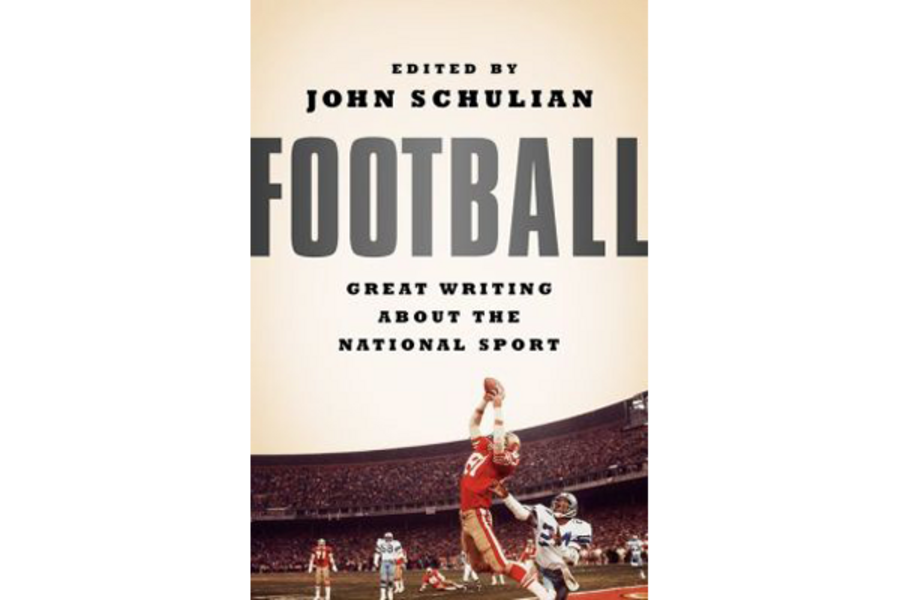'Football: Great Writing About the National Sport' touches on the good, bad, and the ugly
Loading...
On a recent episode of "The Daily Show," host Jon Stewart ripped the National Football League and Commissioner Roger Goodell for suspending a player for just two games during the upcoming season.
The player, Ray Rice of the Baltimore Ravens, was filmed dragging his unconscious fiancée from a casino elevator in February. Rice is believed to have punched her before the elevator doors opened. The video shows the NFL player pulling the woman, who is now his wife, without her showing any signs of consciousness.
Stewart, in an expert send-up of our collective football hysteria and hypocrisy, then conducted an interview with a Comedy Central correspondent standing in front of the Ravens’ stadium. The correspondent discussed the physical violence of the game, various ethical lapses carried out by the powerful NFL (such as ignoring domestic violence), and the constant extortion of taxpayers by teams seeking publicly financed stadiums.
“It is time to say it: The NFL is a morally indefensible organization,” the correspondent, Jason Jones, told Stewart. “Of course, that being said, man, am I glad training camps are back! I am ready for some football!”
Most of us share the sentiment, even when we know it defies logic and good judgment. In Football: Great Writing About the National Sport, anthology editor John Schulian, a former sports columnist-turned-Hollywood-writer, and co-editor of an earlier collection of boxing stories for the Library of America, spares no one in his choices.
Obsessed fans (Frederick Exley’s “A Fan’s Notes”), football orphans (Jennifer Allen, daughter of George Allen, recounts her father’s frequent absences and the mood swings induced by the pressure cooker of coaching in the NFL,) and legions of mangled players litter the literary landscape curated by Schulian.
In these pages readers meet Dave Duerson, the former Chicago Bears defensive back whose traumatic head injuries and concussions in pro football are considered by some experts to be contributing factors to his suicide at age 50. Junior Seau, Mike Webster, and Andre Waters, all standout veteran players in the NFL, killed themselves and were either believed to or confirmed to have suffered from brain trauma.
Paul Solotaroff profiles Duerson and his suffering in detail. Chronic traumatic encephalopathy, or CTE, as the diagnosis is known, is described by the writer as a “neuron-killing condition … rampant these days among middle-aged veterans of the National Football League.… It was a bad way to die and a worse way to live, warehoused for decades in a fog, unable, finally, to know your own kids when they came to see you at the home.”
Now are you ready for some football? Maybe not.
Elsewhere, Al Silverman chronicles the agony of Hall of Famer Gale Sayers returning from knee surgery while Mark Kram, in a story for Esquire, describes the toll of Sunday afternoons.
“It is Monday morning, and all over the land the bill is being presented to some large, tough men for playing so fearlessly with the equation of mass times velocity; only the backup quarterback bullets out of bed on recovery day,” he writes. “The rest will gimp, hobble, or crawl to the bathroom, where contusions are counted like scattered coins, and broken noses, ballooned with mucus and blood, feel like massive ice floes.”
But while Schulian does not turn away from the dark side of football, neither does he forget the joy, inspiration, and even the humor to be found in the game. His selections are peerless. Portions of H.G. Bissinger’s “Friday Night Lights” and “When Pride Still Mattered,” the standout biography of Vince Lombardi by moonlighting political writer David Maraniss, are, thankfully, here, as is the late Jim Murray’s artful account of mouthy Joe Namath making good on his guaranteed victory in Super Bowl III.
A forgotten gem emerges in New York novelist Richard Price’s 1979 portrait of Alabama coach Bear Bryant. Sitting across from the gravelly voiced, mumbling coach in his Tuscaloosa office, Price sees a 66-year-old man whose face “is like an aerial shot of a drought area.” As for the interview? “I can’t understand a damn thing he says.”
Here, too, is George Plimpton’s delightfully disastrous pre-season experiment as a member of the Detroit Lions and Sports Illustrated’s Frank Deford recounting the glories of Baltimore Colts quarterback Johnny Unitas.
Deford, a Baltimore native, writes, “Johnny U’s talents were his own. The belief he gave us was his gift.”
As for Plimpton, his participatory football journalism exists in a distant universe from Unitas. Sent into a Lions’ intrasquad scrimmage to play quarterback, Plimpton, in his 1966 account, explained that he “had lost twenty yards in three attempts, and I had yet, in fact, to run off a complete play.”
Most surprising to this reader was a story by Jeanne Marie Laskas about the Cincinnati Bengals cheerleaders. It appeared in GQ in 2008 and pulls off the Wallenda-esque feat of taking women viewed as sideline Barbies and turning them into real, and resilient, people.
One is a construction worker (really) named Adrienne whose stepfather murdered her mother when Adrienne was 1. Another, named Rhoneé, commutes three hours each way, all for $75 a game, no interaction with the players, and a military-style regimen.
Conclusion: other than the billionaires who own NFL teams, no one in football has it easy. Which, for better and worse, helps explain why we can’t stop watching the glamorous wreckage before us.








